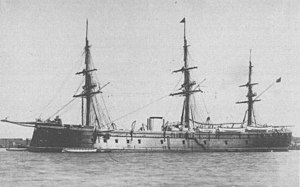Spanish ironclad Numancia
 Numancia at anchor
| |
| History | |
|---|---|
| Name | Numancia |
| Namesake | Siege of Numantia |
| Builder | La Seyne , France |
| Laid down | 22 January 1861 |
| Launched | 19 November 1863 |
| Commissioned | 17 December 1864 |
| Refit | 1896–1898 |
| Stricken | 1912 |
| Fate | Sank while under tow, 17 December 1916 |
| General characteristics (as built) | |
| Type | Broadside ironclad |
| Displacement | 7,305 t (7,190 long tons) |
| Length | 95.6 m (313 ft 8 in) |
| Beam | 17.3 m (56 ft 9 in) |
| Draft | 7.7 m (25 ft) |
| Installed power |
|
| Propulsion | 1 shaft, 1 horizontal-return connecting-rod steam engines |
| Sail plan | Ship rig |
| Speed | 12.7 knots (23.5 km/h; 14.6 mph) |
| Range | 3,000 nautical miles (5,600 km; 3,500 mi) at 10 knots (19 km/h; 12 mph) |
| Complement | 561 |
| Armament | 40 × 68-pounder (203 mm) smoothbore guns |
| Armor | |
The Spanish ironclad Numancia was an
Design and description

Numancia was 95.6 meters (313 ft 8 in) long at the waterline, had a beam of 17.3 meters (56 ft 9 in) and a draft of 7.7 meters (25 ft 3 in).[2] She displaced 7,305 metric tons (7,190 long tons) and was fitted with a ram bow.[3] Her crew consisted of 561 officers and enlisted men.[2]
The ship was fitted with a pair of
The frigate's
Numancia had a complete wrought iron waterline belt of 130-millimeter (5.1 in) armor plates. Above the belt, the guns were protected by a 120-millimeter (4.7 in) strake of armor that extended the length of the ship. The deck was unarmored.[4]
Construction and career
In 1866 the ship was a core of Spanish escadre sent to Eastern Pacific participating in the
On 19 October 1873,
In November 1902 she was ordered to Ceuta to protect Spanish citizens in Morocco during unrest in that country.[12]
On August 5, 1911 a mutiny occurred while in Tangiers. The mutineers were overpowered and put in irons after which the ship steamed for Cadiz. Once there 26 mutineers were tried by court martial and condemned to death. At 9 am on 8 August 1911 they were given communion and immediately executed.[13]
While being towed to be scrapped in
References
- ^ Pastor y Fernandez de Checa, pp. 3–4
- ^ a b c de Saint Humber, p. 23
- ^ a b c Silverstone, p. 388
- ^ a b de Saint Hubert, pp. 22–23
- ^ a b Lyon, p. 380
- ^ de Saint Hubert, pp. 22, 24
- ^ de Saint Hubert, p. 27
- ^ Lyon 1979, p. 380.
- ^ Antequera Becerra, Luis (October 2023). "Juan Bautista Antequera y Boadila. El héroe de la Numancia que fundó la Revista General de Marina y previó el desastre del 98". Revista General de Marina: 321–336.
- ^ "The Cartagena Insurrection". The Times. No. 27838. London. 4 November 1873. col F, A-D, p. 9-10.
- ^ Pastor y Fernandez de Checa, p. 4
- ^ "Latest Intelligence - Morocco". The Times. No. 36927. London. 17 November 1902. p. 1.
- ^ "9 Aug 1911". Boston Globe. Retrieved 2021-08-28.
- ^ Pastor y Fernandez de Checa, p. 5
- ^ "O Centenário do Numancia". sesimbra.pt (in Portuguese).
Bibliography
- Adamson, Robert E. & de St. Hubert, Christian (1991). "Question 12/89". Warship International. XXVIII (2): 199–205. ISSN 0043-0374.
- OCLC 669097244.
- de Saint Hubert, Christian (1984). "Early Spanish Steam Warships, Part II". Warship International. XXI (1): 21–45. ISSN 0043-0374.
- Lyon, Hugh (1979). "Spain". In Chesneau, Roger & Kolesnik, Eugene M. (eds.). Conway's All the World's Fighting Ships 1860–1905. Greenwich, UK: Conway Maritime Press. pp. 380–386. ISBN 0-8317-0302-4.
- Pastor y Fernandez de Checa, M. (1976). "The Spanish Ironclads Numancia, Vitoria and Pelayo, Pt. II". F. P. D. S. Newsletter. IV (1). Akron, Ohio: F. P. D. S.: 3–5. OCLC 41554533.
- Silverstone, Paul H. (1984). Directory of the World's Capital Ships. New York: Hippocrene Books. ISBN 0-88254-979-0.
- "Spanish Ironclads Numancia and Vitoria". Warship International. VIII (3): 287–289. 1970. ISSN 0043-0374.
